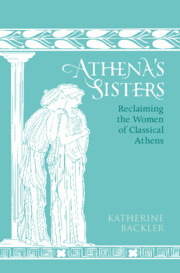Refine listing
Actions for selected content:
1299800 results in Books
Chapter 14 - Cooperation in Large Societies
- from Part VI - Topics in Microeconomic Theory
-
-
- Book:
- Advances in Economics and Econometrics
- Published online:
- 28 November 2025
- Print publication:
- 31 January 2026, pp 389-440
-
- Chapter
- Export citation
Part I - Frisch Lecture
-
- Book:
- Advances in Economics and Econometrics
- Published online:
- 11 November 2025
- Print publication:
- 31 January 2026, pp 1-2
-
- Chapter
- Export citation
List of Abbreviations
-
- Book:
- International Arbitration and India
- Published online:
- 16 December 2025
- Print publication:
- 31 January 2026, pp xix-xx
-
- Chapter
- Export citation
Contents
-
- Book:
- Sarah Wambaugh and the Plebiscite
- Published online:
- 23 December 2025
- Print publication:
- 31 January 2026, pp vii-viii
-
- Chapter
- Export citation

Athena's Sisters
- Reclaiming the Women of Classical Athens
- Coming soon
-
- Expected online publication date:
- January 2026
- Print publication:
- 12 February 2026
-
- Book
- Export citation
Explanatory Notes
-
- Book:
- Chance
- Published online:
- 26 December 2025
- Print publication:
- 31 January 2026, pp 691-710
-
- Chapter
- Export citation
Bibliography
-
- Book:
- The Indian Ocean and the Historical Imagination in Afro-Asian Fiction
- Published online:
- 19 December 2025
- Print publication:
- 31 January 2026, pp 237-256
-
- Chapter
- Export citation
Chapter 1 - Individual and SocialWelfare: A Bayesian Perspective
- from Part I - Frisch Lecture
-
-
- Book:
- Advances in Economics and Econometrics
- Published online:
- 11 November 2025
- Print publication:
- 31 January 2026, pp 3-46
-
- Chapter
- Export citation
Introduction
-
- Book:
- Sarah Wambaugh and the Plebiscite
- Published online:
- 23 December 2025
- Print publication:
- 31 January 2026, pp 1-19
-
- Chapter
- Export citation
Chapter 1 - Language
-
- Book:
- The Indian Ocean and the Historical Imagination in Afro-Asian Fiction
- Published online:
- 19 December 2025
- Print publication:
- 31 January 2026, pp 27-57
-
- Chapter
- Export citation
Chance
- from Chance, A Tale in Two Parts
-
- Book:
- Chance
- Published online:
- 26 December 2025
- Print publication:
- 31 January 2026, pp 9-349
-
- Chapter
- Export citation
1 - Growing with and beyond the Red Cross Movement: The Relief Work of the Indian St. John Ambulance Association during the First World War
-
- Book:
- Between Empire and Nation
- Published online:
- 15 December 2025
- Print publication:
- 31 January 2026, pp 35-82
-
- Chapter
-
- You have access
- Open access
- Export citation
6 - The Politics of Failure
- from Part II - Delivery
-
- Book:
- Charity After Empire
- Published online:
- 18 December 2025
- Print publication:
- 31 January 2026, pp 165-195
-
- Chapter
- Export citation
7 - Who Is Aid For?
- from Part II - Delivery
-
- Book:
- Charity After Empire
- Published online:
- 18 December 2025
- Print publication:
- 31 January 2026, pp 196-228
-
- Chapter
- Export citation
Chapter 3 - Incomplete-Information Models for Industrial Organization
- from Part II - Topics in Industrial Organization
-
-
- Book:
- Advances in Economics and Econometrics
- Published online:
- 28 November 2025
- Print publication:
- 31 January 2026, pp 71-124
-
- Chapter
- Export citation
Chapter 4 - Advances in Horizontal Merger Analysis
- from Part II - Topics in Industrial Organization
-
-
- Book:
- Advances in Economics and Econometrics
- Published online:
- 28 November 2025
- Print publication:
- 31 January 2026, pp 125-150
-
- Chapter
- Export citation
9 - The Political Challenges Hindutva May Face in the Years to Come
-
-
- Book:
- The Politics of Corporations in ‘New’ India
- Published online:
- 15 December 2025
- Print publication:
- 31 January 2026, pp 216-245
-
- Chapter
- Export citation
Frontmatter
-
- Book:
- Chance
- Published online:
- 26 December 2025
- Print publication:
- 31 January 2026, pp i-xii
-
- Chapter
- Export citation
Chapter 6 - Synthetic Controls in Action
- from Part IV - Modern Causal Inference
-
-
- Book:
- Advances in Economics and Econometrics
- Published online:
- 11 November 2025
- Print publication:
- 31 January 2026, pp 195-224
-
- Chapter
- Export citation
Chapter 3 - The Unreasonable Effectiveness of Optimal Transport in Economics
- from Part II - Frontiers of Modern Econometrics
-
-
- Book:
- Advances in Economics and Econometrics
- Published online:
- 11 November 2025
- Print publication:
- 31 January 2026, pp 90-114
-
- Chapter
- Export citation
